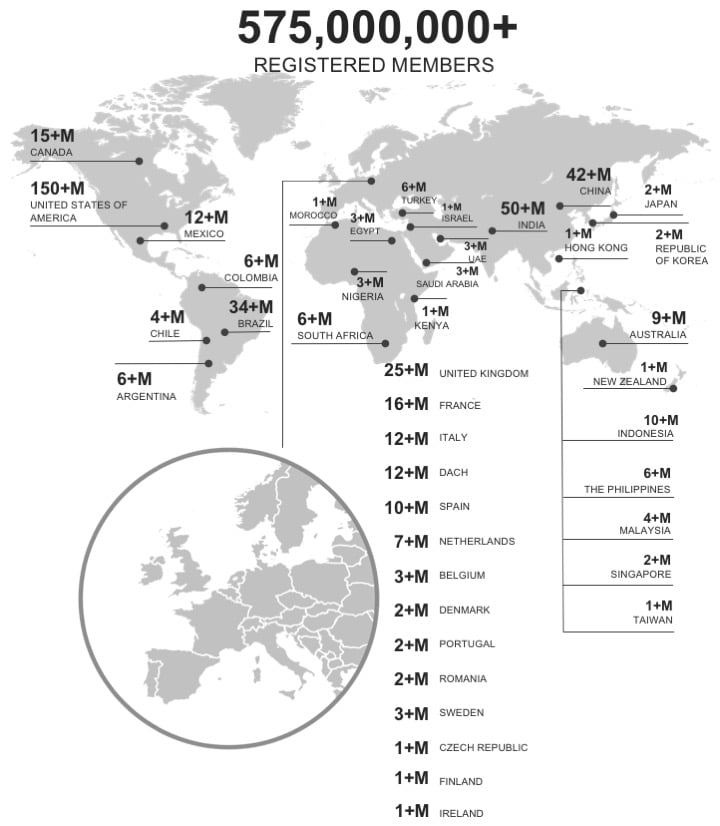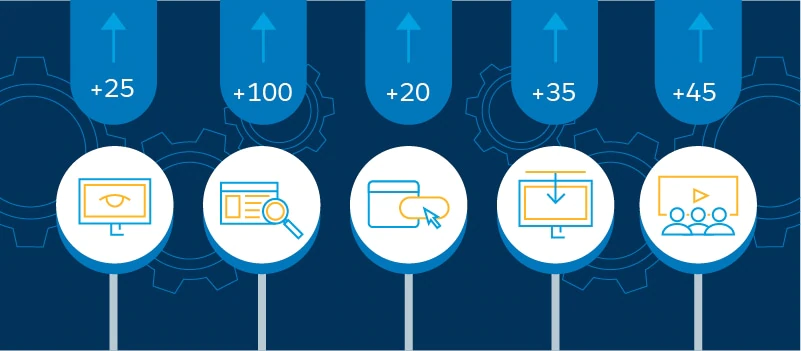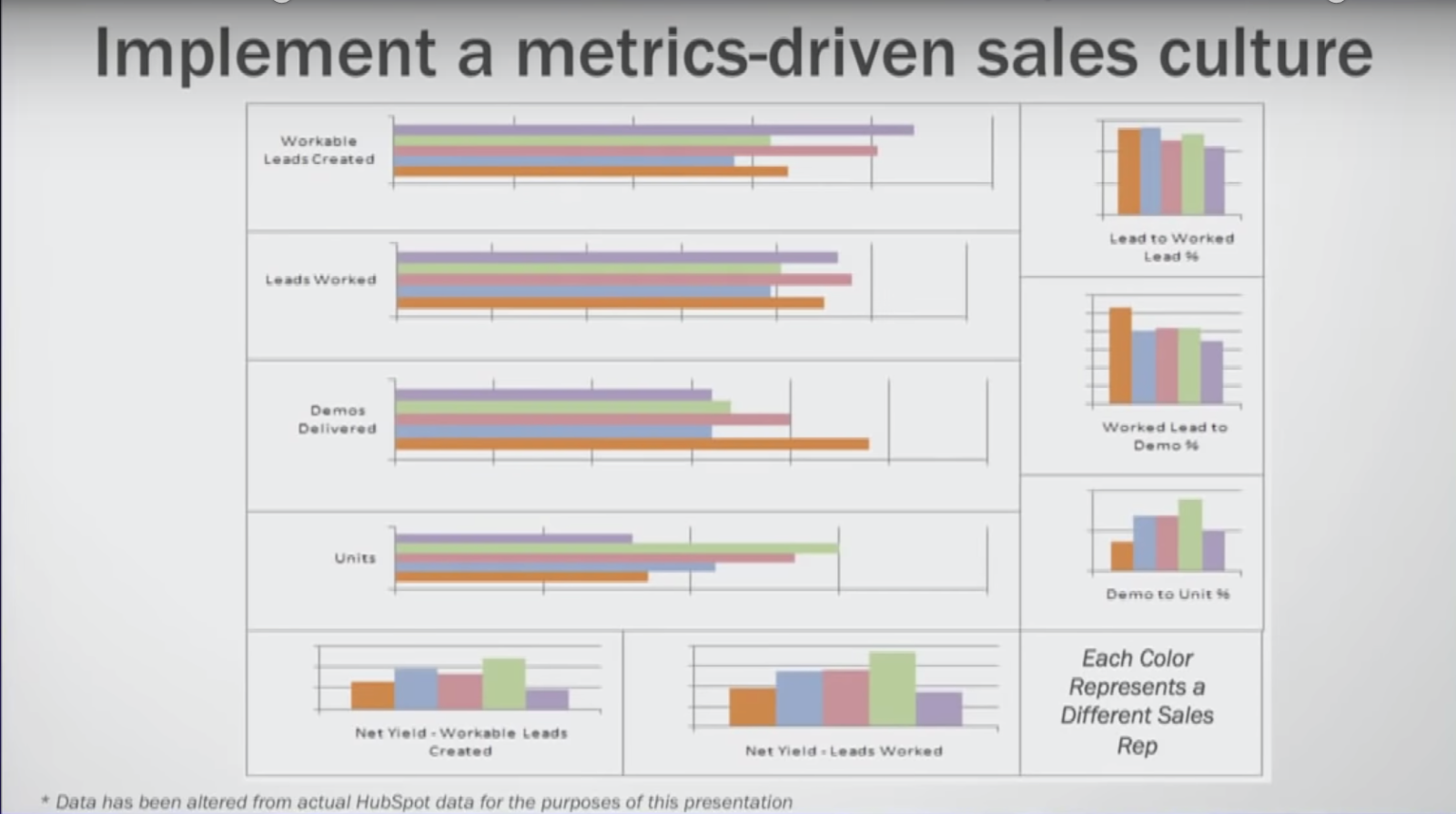The sales acceleration formula involves using three key things to move leads through the sales cycle more quickly — data, technology, and inbound selling.
Based on a 2015 book by former chief revenue officer of HubSpot, Mark Roberge, this formula focuses less on innovation and outgunning competitors and more on developing a predictable, scalable path to generate massive revenue growth.
Here’s a summary of the sales acceleration formula, along with takeaways and tactics you can use to move leads through your sales cycle at warp speed.
Key Highlights on the Sales Acceleration Formula:
- Data-Driven Approach: Utilizes data to define and replicate the success of sales strategies, ensuring a predictable and scalable sales process.
- Strategic Hiring: Emphasizes hiring the right sales talent using a specific, data-backed profile to consistently recruit top performers.
- Comprehensive Training: Advocates for a structured, scalable training program tailored to a company’s unique sales process and buyer journey.
- Effective Management: Focuses on managing sales teams with metrics and technology, enabling data-driven decisions and accountability.
- Leverage Technology: Highlights the importance of CRM systems, analytics tools, and other technologies to accelerate sales and enhance efficiency.
What is The Sales Acceleration Formula?
“The Sales Acceleration Formula” is a book written by Mark Roberge, who was the Chief Revenue Officer of HubSpot, a major inbound marketing company.
In this book, Roberge shares his experience and insights into building a successful sales strategy. The formula he proposes focuses on the use of data, technology, and inbound selling to build a high-performing sales organization.
Key elements of The Sales Acceleration Formula include:
- Hiring: Roberge emphasizes hiring the right salespeople using a data-driven approach. He suggests creating a specific profile for successful salespeople and using this as a guideline for recruitment.
- Training: The book highlights the importance of training sales staff effectively, focusing on a consistent and scalable training process.
- Management: Roberge discusses how to manage salespeople using metrics and a data-driven approach, advocating for the use of technology to track and analyze sales performance.
- Demand Generation: The formula also includes strategies for creating customer demand, primarily through inbound marketing techniques.
- Technology: Emphasizing the role of technology in modern sales, the book talks about leveraging CRM systems, analytics tools, and other tech solutions to accelerate sales.
Overall, the book provides a comprehensive guide to building a scalable, predictable, and efficient sales process by combining strategic hiring, training, management, and the use of technology.
It’s particularly aimed at those in leadership roles within sales organizations or businesses looking to improve their sales operations.
Where Did the Sales Acceleration Formula Originate?
If you’re unfamiliar with this concept, I recommend reading this article on sales acceleration for a full rundown on what the concept entails and the strategies that go into it.
But as a quick recap, sales acceleration is about creating a more efficient sales process, using the right combination of sales tools, and developing winning behavior in sales reps.

As the name implies, the sales acceleration formula is the specific approach behind this strategy and is the basis of the book that Mark Roberge wrote.

It’s what he used to help take HubSpot from being a fledgling sales and marketing software to having over 10,000 customers in 60 countries and generating $100 million in revenue in just seven years.
The bottom line is the sales acceleration formula is a concept that originated in Mark Roberge’s book and what he used to turn HubSpot into the beast that it is today.
Sales Acceleration Formula Summary
Now that we have a better understanding of the context, let me explain exactly what this formula is.
The Sales Acceleration Formula provides a scalable, predictable approach to growing revenue and building a winning sales team.”
It’s about taking a data-driven approach in order to develop a repeatable process to streamline the sales cycle, remove friction, and get leads “across the finish line” more quickly.
And the key word here is “data-driven.”
It should be noted that Roberge is an MIT graduate and has a background in engineering, which is a big reason why he places such a heavy emphasis on tapping into metrics.
He understands that even though being innovative can help software companies gain an edge initially, eventually the competition will catch up.
So you can’t safely rely on just being innovative or having a sleek, sexy new approach to create sustained growth.
Rather, you need a process-oriented system, using objective data that you can rinse and repeat.
There are five key elements that go into the sales acceleration formula.
- The Sales Hiring Formula – Hire the same successful salesperson every time.
- The Sales Training Formula – Train every salesperson in the same manner.
- The Sales Management Formula – Hold salespeople accountable to the same sales process.
- The Demand Generation Formula – Provide salespeople with the same quality and quantity of leads every month.
- Technology – Leverage technology to enable better buying for customers and faster selling for salespeople.
For a full overview of the sales acceleration formula, get it straight from the horse’s mouth in this talk from Mark Roberge himself.
Sales Acceleration Formula Takeaways and Tactics
Now let’s dive into some of the main takeaways and tactics — actionable tips you can implement into your own sales process.
The Sales Hiring Formula
First, you need to define what makes a successful sales rep.
One particular point Roberge makes is that this definition can vary considerably from company to company, depending upon multiple factors, such as industry, size, customer demographics, and so on.
That said, he was able to come up with some quantitative data on what traits he found most important, especially when it comes to technology and software sales.
Here’s a chart that he used in his video.

Interestingly, what have historically been considered positive traits like convincing and closing ability were actually negatively correlated with success in his model.
Roberge elaborated saying that old school, aggressive, pushy sales tactics are no longer as effective as they once were, and now most customers value a rep that’s helpful, trustworthy, and acts more as a consultant or advisor.
And when it comes to the main characteristics modern companies should look for, there are five that outshine all others.

So, as a rule of thumb, these are the main traits to keep in mind when you’re looking for sales reps.
As for finding these rockstars, Roberge makes a great point that taking conventional hiring routes like going through a recruiting agency or using job boards aren’t usually the best ways to go about it.
After all, elite sales reps probably don’t need to apply for a job — they’re often headhunted, where recruiters come to them.
And that’s the approach Roberge suggests taking.
More specifically, he says that it’s smart to create your own internal recruiting team and use LinkedIn to find qualified candidates in your industry.
And this makes sense considering LinkedIn currently has over 575 million registered users, with 260 million being active on the site each month.

The Sales Training Formula
Roberge says that after analyzing top sales performers, he quickly realized that they each had their own distinct skills or “superpowers.”
For example, one rep named Adam was an “activity hound” and was all about volume, where his success largely boiled down to his ability to multitask and call a ton of prospects.
In fact, he had about 40% higher volume than other sales reps on his team.
And another rep named Jen was an amazing rapport builder, where her ability to build trust and make prospects legitimately like her was the key ingredient to her success.
One of the main mistakes many companies make with sales training is having a person with one superpower shadowing a person with a completely different superpower because it’s neither predictable nor scalable.
The solution?
Build a training program that’s designed around your company’s unique buyer journey and sales process — something that can be done by creating buyer personas, says Patrick Biddiscombe, CEO of New Breed.
Here’s a super simple example.

And to ensure continual progress, take the time to analyze your sales leaders against your current training program.
Then, make iterative steps to ensure your training program matches the needs of your team, and get consistent feedback to identify areas of improvement.
In other words, get your reps in on the action and keep it collaborative.
The Sales Management Formula
Again, the crux of the sales acceleration formula is having a systematized process that can be applied across the board to enhance the performance of your collective sales team.
That’s why Roberge suggests doing three main things with sales management.
First, you’ll want to use quantifiable metrics to track the performance of each rep throughout each stage of the sales funnel.
From there, you can see what their strengths, as well as what their weaknesses are.
Maybe, for instance, a rep does a great job during their product demo and paints a clear picture of how your product will simplify a prospect’s life.
So, they’re good up until stage four of the sales funnel illustrated here.

But, during stage five of evaluation where the customer brings up the concerns and objections they have, your rep struggles and ends up squandering a large percentage of leads.
This would be the obvious area where you would want to help your rep improve.
Next, you’ll want to come up with a framework for offering the right incentives to boost the performance of sales reps.
Say, for example, a rep is solid at making the initial sale, but experiences a higher than average churn rate.
You may want to give them half of the commission when they make the sale and the other half a few months later
And finally, Roberge talks about the importance of promoting from within.
According to research, “Internally promoted employees perform better than external hires and are less likely to leave their jobs on their own accord.”
So, this is often integral to developing a rapid fire sales cycle.
The Demand Generation Formula
As you might imagine, being part of HubSpot, Roberge heavily favors inbound marketing over traditional cold calling.
And who can blame him?
In an era when consumers have unprecedented control, it just makes more sense to use “pull” techniques like SEO, blogging, social media, and content marketing rather than traditional “push” techniques where you’re trying to shove annoying advertising down someone’s throat.
Here are some specific types of inbound marketing projects that should be top priorities, according to HubSpot.

The other main part of the demand generation formula is giving your reps the same quality and quantity of leads, as this helps greatly in establishing a systematic, repeatable process.
And that’s something that can easily be done via round robin routing.
This ensures fair lead distribution, where everyone gets the same level of opportunity by cycling through a group of sales reps every time a new meeting is booked.
It also saves a ton of time because there’s no need for manual routing, thus dramatically increasing your speed to lead.
Technology
The last piece of the puzzle is technology, where Roberge suggests using tools to better equip your salespeople for success.
Here’s a quick refresher of some specific tools that are helpful:
- Lead scoring
- Lead routing
- Marketing automation software
- Real-time alerts
- Email tracking
- Predictive analytics
I find that lead scoring is especially helpful because it provides you with quantitative data based on specific actions, like viewing a pricing page or watching a demo, that can be used to prioritize leads.

And lead routing is great because you can efficiently get hot leads to the right reps without any drama or friction.
Like I mentioned before, you can use round robin routing to ensure fair distribution and create a smooth lead handoff, which is incredibly important.
Prospects simply choose a time that’s convenient for them.
Building a Metrics-Driven Sales Culture
Before I wrap up, there’s one last piece of advice Roberge offers — and that’s taking steps to make your overall company culture more metrics-driven.
He mentions that the default response of many non-metrics-driven sales managers when one of their reps is underperforming is that it’s simply an activity problem, where the rep isn’t getting the volume of leads they need.
But Roberge disagrees by offering this example, where the rep who’s represented with the purple graph bar is receiving the highest volume of leads but selling the least amount of products.

So, the overarching theme of the sales acceleration formula is to stop basing your approach on intuition or “a hunch,” and always look to the data.
“Data-driven sales is an approach to sales in which sales teams collect data and use it to inform every decision they make, from the products they sell to the time of day they reach out to prospects and customers,” explains Steve Bookbinder of ImpactBND.
Following this path keeps your approach objective and is integral to making it predictable and scalable.
Sales Acceleration Formula FAQs
What’s the sales acceleration formula?
It “provides a scalable, predictable approach to growing revenue and building a winning sales team.”
Who created it?
Mark Roberge, former chief revenue officer of HubSpot.
What’s the core approach?
Using data to design a more systematic sales process that moves leads through the sales cycle more quickly.
What are some specific tactics of the sales acceleration formula?
- Choosing salespeople with key traits like being coachable, curious, and intelligent, while possessing work ethic and having a record of success
- Designing a sales training program around your company’s unique buyer journey and sales process
- Holding reps accountable and continually striving to improve upon their weaknesses
- Providing reps with the same quality and quantity of leads
- Using technology to enable faster selling and reduce inefficiencies
Killing it With the Sales Acceleration Formula
As a person who’s all about the data, the sales acceleration formula resonates with me on a personal level.
And judging by the insane level of success HubSpot has had (it reached $674.9 million in revenue in 2019), it obviously works.

The proof is in the pudding.
It’s just a matter of taking the approach and strategies Mark Roberge outlines and applying to your company.
A version of this post was originally published here.